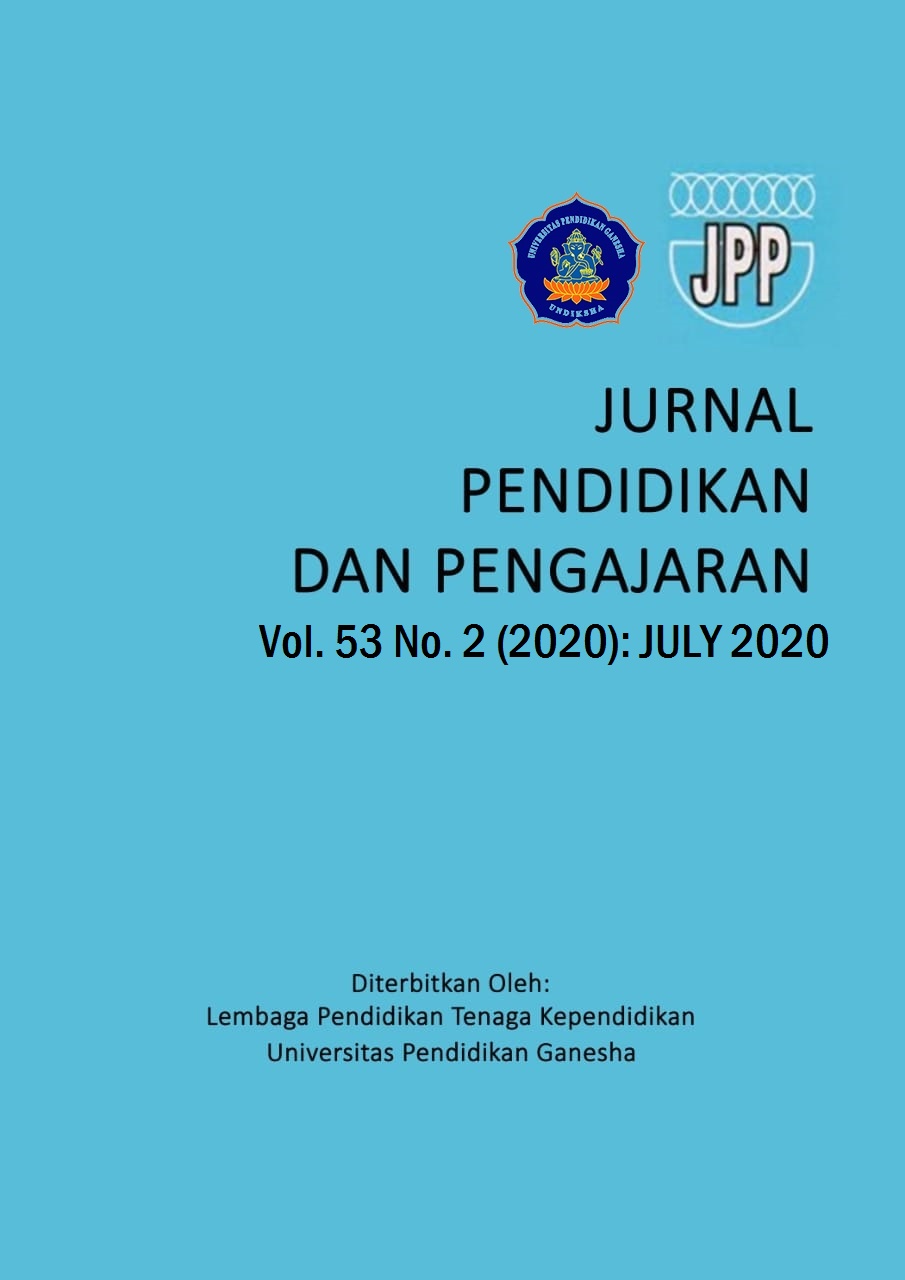Student Responses on The Application of Hypnoteaching Method in Learning Hindu Religious Education
DOI:
https://doi.org/10.23887/jpp.v53i2.23346Keywords:
Students response, Hypnoteaching, Increase learning activitiesAbstract
This research aims to identify and analyse students’ response on the application of the Hypnoteaching in learning Hindu religious education in class X of SMAN 7 Denpasar. This research follows a qualitative approach with observation as the main data collection technique. The sample of the study is X MIPA 6 class with 34 students from a total of 389. The application of hypnoteaching methods is fun for students compared to conventional methods which tend to be uninteresting. When using Hypnoteaching method, students were very excited during learning activities. By using hypnoteaching methods in learning Hindu religious education students becomes very enthusiastic in listening to the teacher's explanation of Hindu religious learning materials. To improve learning activities students prepare themselves for the topic discussion. Students’ response to the application of Hypnoteaching method is positive. They think that the method is effective as it can increase students’ enthusiasm to learn.
References
Bogdan, R. ., & Biklen, S. K. (2007). Qualitative Research for Education. An Introduction to Theories and Methods 5th ed. Allyn and Bacon.
Bryant, R. A., Moulds, M. L., Guthrie, R. M., & Nixon, R. D. V. (2005). The additive benefit of hypnosis and cognitive-behavioral therapy in treating acute stress disorder. Journal of Consulting and Clinical Psychology. https://doi.org/10.1037/0022-006X.73.2.334
Budiarso, A. S. (2016). Pengembangan Bahan Ajar Berbasis Metode Hypnoteaching untuk Memotivasi Siswa SMP dalam Belajar IPA Pada Materi Energi Terbarukan. Jurnal Pena Sains.
Dewantara, I. P. M. A. S. (2012). Identifikasi Faktor Penyebab Kesulitan Belajar Keterampilan Berbicara Siswa Kelas VIIIE Smpn 5 Negara Dan Strategi Guru Untuk Mengatasinya. Jurnal Pendidikan Dan Pembelajaran Bahasa Indonesia.
Dewi P.F., K. A. P., & Budimansyah, D. (2016). The Community-Based Value Education to Develop Environmental Awareness Characters for Elementary School Students. https://doi.org/10.2991/icse-15.2016.23
Ega Rima Wati & Kusuma Shinta. (2016). Menjadi guru hebat dengan Hypnoteaching. Kata Pena.
Green, J. P., Barabasz, A. F., Barrett, D., & Montgomery, G. H. (2005). Forging ahead: The 2003 APA Division 30 definition of hypnosis. In International Journal of Clinical and Experimental Hypnosis. https://doi.org/10.1080/00207140590961321
Green, J. P., & Lynn, S. J. (2000). Hypnosis and suggestion-based approaches to smoking cessation: An examination of the evidence. In International Journal of Clinical and Experimental Hypnosis. https://doi.org/10.1080/00207140008410048
Hakim, A. (2011). Hypnosis in The Teaching: Cara Dahsyat Mendidik dan Mengajar. Visimedia.
Holroyd, J. (2003). The Science of Meditation and the State of Hypnosis. American Journal of Clinical Hypnosis. https://doi.org/10.1080/00029157.2003.10403582
Kasmaja, H. (2016). Efektivitas Implementasi Metode Hypnoteaching untuk Meningkatkan Motivasi dan Hasil Belajar Matematika Pada Siswa SMP Negeri. Journal of Educational Science and Technology (EST). https://doi.org/10.26858/est.v2i1.1889
MACLEAN, P. D. (1949). Psychosomatic Disease and the “Visceral Brain.” Psychosomatic Medicine. https://doi.org/10.1097/00006842-194911000-00003
Newman, J. D., & Harris, J. C. (2009). The scientific contributions of Paul D. MacLean (1913-2007). In Journal of Nervous and Mental Disease. https://doi.org/10.1097/NMD.0b013e31818ec5d9
Noer, M. (2010). Hypnoteaching for success learning. Pt Pustaka Insan Madani.
Pritchett, L. (2001). Where Has All the Education Gone? The World Bank Economic Review. https://doi.org/10.1093/wber/15.3.367
Sudarsana, I. K., Dewi, N. L. P. S. S., Sukarmiasih, N. P., Resna, I. K., Arini, I. A. M. P., Restiti, N. W., Suryawan, I. W., & Limbong, T. (2018). Paradigma Pedidikan Bermutu Berbasis Teknologi Pendidikan. Jayapangus Press Books.
Sugiyono. (2016). Memahami Penelitian Kualitatif. Bandung: Alfabeta.
Utami, I. L. P., Prestridge, S., Saukah, A., & Hamied, F. A. (2019). Continuing Professional Development and teachers ’ perceptions and practices - A tenable relationship. Indonesian Journal of Applied Linguistics, 9(1), 108–118. https://doi.org/10.17509/ijal.v9i1.12463
Downloads
Published
How to Cite
Issue
Section
License
Authors who publish with Jurnal Pendidikan dan Pengajaran agree to the following terms:- Authors retain copyright and grant the journal the right of first publication with the work simultaneously licensed under a Creative Commons Attribution License (CC BY-SA 4.0) that allows others to share the work with an acknowledgment of the work's authorship and initial publication in this journal
- Authors are able to enter into separate, additional contractual arrangements for the non-exclusive distribution of the journal's published version of the work (e.g., post it to an institutional repository or publish it in a book), with an acknowledgment of its initial publication in this journal.
- Authors are permitted and encouraged to post their work online (e.g., in institutional repositories or on their website) prior to and during the submission process, as it can lead to productive exchanges, as well as earlier and greater citation of published work. (See The Effect of Open Access)





